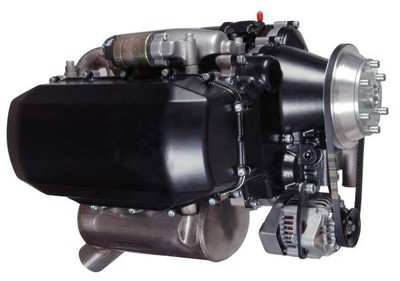Gemini 100 Sports Impressive Power, Low Weight
Powerplant Developments, a UK company, in a joint development
effort with Weslake Air Services and Jade Air, unveiled plans
Tuesday at AirVenture 2007 to produce a diesel engine intended for
the LSA market.

Tim Archer, President of Powerplant Developments, said the
company has been working nonstop over the last seven months to make
their idea a reality. Weslake Engineering is known for engineering
Formula 1 racing engines, and recently expanded to help build the
Gemini. Jade Air, which has been around since the 1970s,
specializes in engine overhaul, repair, and engineering
consulting.
Derek Graham, Chairman and Co-founder of Powerplant
Developments, detailed the build process and outlined many of the
engine's features. Graham believes that Europe has been forced to
lead in diesel engines because of fuel prices, and the US will be
soon to follow.

"The LSA category represents the future of this industry,"
Graham explains. LSA manufacturers consulting with Powerplant
Developments desired an engine capable of 100 horsepower and
weighing 150 pounds. Fuel efficiency was a big concern, as well as
fuel availability.
The answer lay in a diesel engine that most had
forgotten.
As Graham says, "I founded my business on the basis of
identifying a market need and satisfying a market need." A lighter
engine for the LSA market was the change most LSA manufacturer's
desired, so the company began to work on concepts for such an
engine. Michael Daniel, head of R&D for Powerplant
Developments, had the idea to resurrect a somewhat unconventional
engine that Graham says "simply fell off the radar."
Powerplant Developments' Gemini 100 is a supercharged 1.6 liter
three cylinder that produces 100 horsepower and weighs a scant 150
pounds. The two-stroke engine has no cylinder heads, valves,
rockers, pushrods or camshafts, simplifying design and making the
engine extremely maintenance-friendly. The Gemini is supercharged
because their design requires forced induction to operate. Since
the supercharger saps 30 horsepower (the engine can actually
produce 130 horsepower), plans are to eventually upgrade to a
turbocharger which would only require five horsepower to run.

The fuel efficiency of the diesel is what essentially motivated
Powerplant Developments, and the Gemini 100, at 75% power at 5,000
feet, consumes 4.75 gallons per our of Jet-A compared to 6.6
gallons per hour of Avgas for a Rotax 912. Since the engine employs
dual crankshafts as well as some other non-conventional aspects,
introducing a training program for this engine will be a priority
for the company.
The Gemini 100 sports two pistons in each of its three
cylinders; the pistons fire toward each other, the mixture
combusts, and they are driven away. Graham notes the technology
originally appeared on Lufthansa aircraft in the 1930s, but was
abandoned in favor of the turbine engine, though no one had
considered its potential as a lightweight engine.
Currently Powerplant Designs is researching a DVD training
program, but as the maintenance schedule is small, and the engine
is designed for a 2000 hour TBO, the transition should be
relatively simple.
"There is very little to do to it," explains Graham.
The first Gemini 100 engines will be available to the
experimental market in mid 2008, and the engine will be ASTM
certified after that. The prototype engines will fly by the end of
September or early October of this year. Cost? "How much will it
cost or how much will I sell it for?" says Graham with a laugh.
Plans are to offer the Gemini 100 for around $18,500, or about 10%
more than the popular Rotax in most LSAs.

The Gemini, which is smaller in every dimension than the Rotax
it will compete with, will allow manufacturers more freedom in
shaping the cowling of their aircraft and designing engine cooling
into the airframe. Current studies by Powerplant Designs have shown
that the Gemini Engines could be designed up to a staggering 600
horsepower.
The Gemini 100 may prove popular not only because of its
efficiency and light weight, but also because of its simplicity.
"The simpler we can make it, the better," says Graham.
 Aero-TV: DeltaHawks Diesel Power Steps Into the Spotlight
Aero-TV: DeltaHawks Diesel Power Steps Into the Spotlight NTSB Prelim: Mooney Aircraft Corp. M20K
NTSB Prelim: Mooney Aircraft Corp. M20K ANN FAQ: Turn On Post Notifications
ANN FAQ: Turn On Post Notifications ANN's Daily Aero-Linx (12.20.25)
ANN's Daily Aero-Linx (12.20.25) Aero-News: Quote of the Day (12.20.25)
Aero-News: Quote of the Day (12.20.25)






